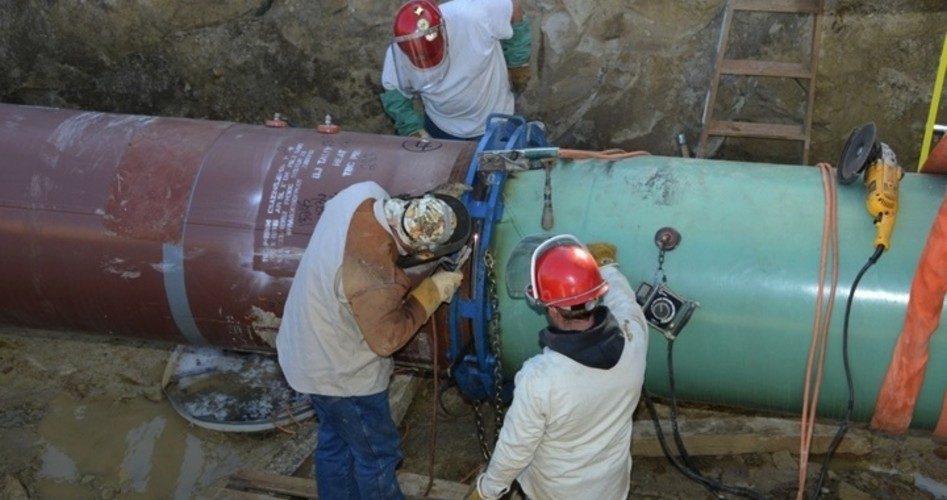
A new environmental analysis on the Keystone XL pipeline is expected to irk environmentalists and opponents of the proposed project. Sources indicate, however, that the analysis is not the final word and does not provide a “specific recommendation,” but officials reveal that the report is ultimately supportive of the pipeline.
Fox News reports, “The release of the long-anticipated evaluation, known as an ‘environmental impact statement,’ sets the stage for a 90-day review period.”
The report is compiled by the State Department, which has jurisdiction over the pipeline since it crosses an international border.
The State Department had released a draft environmental report last March that did not raise any major objections to the pipeline, asserting that other options of getting oil from Canada to the Gulf Coast are generally worse for the environment.
The State Department was then required to conduct a new environmental analysis after the pipeline operator, TransCanada, changed the pipeline’s route through Nebraska.
The American Petroleum Institute believes that the new report will not differ significantly from the March 2013 draft study, based on conversations the Institute has had with officials in the Obama administration.
“We are not expecting any changes,” Cindy Schild, senior manager of refining and oil sands for API, told Politico. “If you look at the analysis, I don’t see where they could pivot on any of those things.”
In 2012, President Obama refused to issue a permit for part of the project due to concerns over the pipeline’s impact on an aquifer in Nebraska.
Meanwhile, TransCanada was given the clearance to build the southern portion of the pipeline running between Oklahoma and the Gulf Coast.
Fox News reports, “Obama backed the southern leg of the project during a 2012 visit to a pipeyard near Cushing, Okla., describing the city as a ‘bottleneck’ between producers and refineries along the Texas Coast. Obama said then that increased oil and gas production was part of his domestic energy policy.”
While the State Department’s findings are not immediately available, government officials assert that Keystone opponents who have argued that the pipeline will carry “dirty oil” and contribute to global warming will likely be disappointed by the report.
One source who supports building the pipeline said the study “confirms there’s no reason to stand in the way of the proposal.”
Advocates of the Keystone Pipeline asserted that the project would create tens of thousands of jobs in the oil industry, and that the construction alone would have created 20,000 jobs.
But environmentalists have protested the pipeline, declaring it would increase the impact of global warming. Opponents have led orchestrated efforts to stop the Keystone project. As The New American has noted, e-mails obtained under a Freedom of Information Act request reveal that the Environmental Protection Agency is plotting with environmental groups to kill the pipeline. The FOIA request was filed by the Energy and Environmental Legal Institute. Lawmakers indicate that the e-mails are “damning.” The e-mails revealed that the EPA had been colluding with environmental groups to ensure that the Keystone XL Pipeline project would not come to fruition.
Environmentalists are begrudging the fact that they have not received any advance notice of the report’s findings. “Why in the world does Big Oil seem to know the findings of the State Department’s report before Congress and the American people do?” asked John Sellers, co-founder of the group The Other 98%. “Because this process has been corrupted by the money and power of Big Oil since the beginning,” he replied.
However, some expect that the report will not be so disappointing to the pipeline’s opponents. Susan Casey-Lefkowitz, director of the Natural Resources Defense Council’s international program, believes that the new study will contain “a better reporting on the climate impacts of this pipeline, and that’s really critical.”
And League of Conservation Voters President Gene Karpinski states, “Any modest changes from the [March draft study] are a step in the right direction.”
The State Department will not provide details as to the exact content or timing of the report, simply stating that the “Environmental Impact Statement is in the final stages of preparation” and that the release of the document will be “soon.”
As noted by Politico, the report is not the “final word” on the pipeline. The State Department must also analyze whether the pipeline will be in the United States’ best interest, “with the final call going to Secretary of State John Kerry and then Obama.”
Photo of pipefitters working on a portion of Keystone XL in Oklahoma: AP Images



